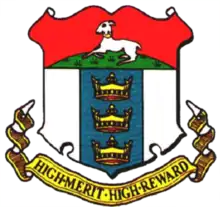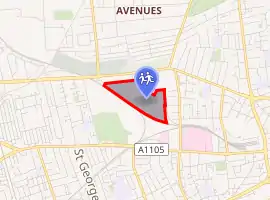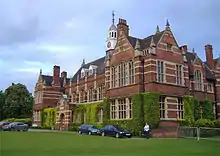Hymers College
Hymers College is a co-educational independent school day school in Kingston upon Hull, located on the site of the old Botanical Gardens. It is one of the leading schools in the East Riding of Yorkshire and a member of the Headmasters' and Headmistresses' Conference.[1]
| Hymers College | |||||||||||||||||||||||||||||||||||||||||||||||||||||||
|---|---|---|---|---|---|---|---|---|---|---|---|---|---|---|---|---|---|---|---|---|---|---|---|---|---|---|---|---|---|---|---|---|---|---|---|---|---|---|---|---|---|---|---|---|---|---|---|---|---|---|---|---|---|---|---|
 | |||||||||||||||||||||||||||||||||||||||||||||||||||||||
| Address | |||||||||||||||||||||||||||||||||||||||||||||||||||||||

| |||||||||||||||||||||||||||||||||||||||||||||||||||||||
Hymers Avenue , , HU3 1LW England | |||||||||||||||||||||||||||||||||||||||||||||||||||||||
| Coordinates | 53.748401°N 0.365094°W | ||||||||||||||||||||||||||||||||||||||||||||||||||||||
| Information | |||||||||||||||||||||||||||||||||||||||||||||||||||||||
| Type | Public school Independent school Day school | ||||||||||||||||||||||||||||||||||||||||||||||||||||||
| Motto | High Merit, High Reward | ||||||||||||||||||||||||||||||||||||||||||||||||||||||
| Religious affiliation(s) | Church of England | ||||||||||||||||||||||||||||||||||||||||||||||||||||||
| Established | 1893 | ||||||||||||||||||||||||||||||||||||||||||||||||||||||
| Founder | The Revd Dr John Hymers JP DD FRS | ||||||||||||||||||||||||||||||||||||||||||||||||||||||
| Local authority | Hull City Council | ||||||||||||||||||||||||||||||||||||||||||||||||||||||
| Department for Education URN | 118131 Tables | ||||||||||||||||||||||||||||||||||||||||||||||||||||||
| Chairman of Governors | Mr J M V Redman | ||||||||||||||||||||||||||||||||||||||||||||||||||||||
| Headmaster | Mr Justin Stanley (since Autumn 2019) | ||||||||||||||||||||||||||||||||||||||||||||||||||||||
| Staff | 105 teaching, 20 support | ||||||||||||||||||||||||||||||||||||||||||||||||||||||
| Gender | Co-educational | ||||||||||||||||||||||||||||||||||||||||||||||||||||||
| Age | 8 to 18 | ||||||||||||||||||||||||||||||||||||||||||||||||||||||
| Enrolment | ~950 | ||||||||||||||||||||||||||||||||||||||||||||||||||||||
| Houses | Brandesburton Gore Holderness Trinity | ||||||||||||||||||||||||||||||||||||||||||||||||||||||
| Colour(s) | Junior School | ||||||||||||||||||||||||||||||||||||||||||||||||||||||
| Publication | The Hymerian | ||||||||||||||||||||||||||||||||||||||||||||||||||||||
| Endowment | 1887 | ||||||||||||||||||||||||||||||||||||||||||||||||||||||
| Affiliations | HMC Hessle Mount School | ||||||||||||||||||||||||||||||||||||||||||||||||||||||
| Alumni | Old Hymerians | ||||||||||||||||||||||||||||||||||||||||||||||||||||||
| Website | www | ||||||||||||||||||||||||||||||||||||||||||||||||||||||
The school was founded following the death in 1887 of the Revd Dr John Hymers, Rector of Brandesburton, who left a substantial sum in his will for the founding of a school "for the training of intelligence in whatever social rank of life it may be found among the vast and varied population of the town and port of Hull". Construction of the buildings was completed in 1893, and the first pupils arrived in September of that year. The school, initially open only to boys, expanded to include girls incrementally from the 1970s, becoming fully co-educational in 1989.[2]
Presently, Hymers educates about 950 pupils aged 8–18 across the Junior and Senior Schools, with about 100 members of the teaching staff. The two major intakes of pupils are at age 8, into Year 4, and age 11, into Year 7. Additionally, some pupils enter at 14, into Year 10, and some at 16, into the Sixth Form. Admissions to the school are based on an examination and interview, or a system of academic tracking from ages 5–8 in its associated preparatory school: Hessle Mount in the East Riding of Yorkshire.
Old Hymerians include several prominent sportspeople, diplomats, and academics, including the physicist Dr Edward Milne MBE FRS, who worked on the problem of the expanding universe, alongside Albert Einstein.
History
Hymers College was founded when the mathematician John Hymers left some of his property to the mayor and corporation of Hull in his will of 24 August 1885. The property was to provide for the founding of a grammar school, "for the training of intelligence in whatever social rank of life it may be found among the vast and varied population of the Town."[3] Although an infelicity in the wording of the will rendered the bequest invalid, his brother and heir, Robert Hymers, voluntarily granted the sum of £50,000 to establish the school.
Hymers opened in 1893, on the site of the old Botanic Gardens of Hull, as a school for boys.[2] The school quickly established itself, and the first headmaster, Charles Gore, was soon admitted into the HMC, with all subsequent headmasters also being members. Hymers was a fee-paying school for most of its history, and many scholarships and bursaries were given to pupils whose parents' could not afford the fees, in accordance with John Hymers' will for the training of intelligence, regardless of social rank. In 1946 Hymers became a "direct grant" school, with many pupils being paid for by the local authority, in a similar system to today's academies. However, this scheme ended in 1971, and the school governors chose to become a fully independent school, rather than joining into the new comprehensive system, and re-established the bursaries system after the Government-funded Assisted Places scheme ended in 1997.[2]
From 1972, girls (initially just two) were admitted to the sixth form, and in 1989 the decision was made to become fully co-educational. With the opening of the Humber bridge in 1981, the school's catchment area increased to cover the south bank of the River Humber, resulting in the school's numbers extending to their current figure of just under one thousand pupils in the 1990s.[2]
Primary education
The College has a Junior School which accepts pupils into Years 4, 5 and 6 via an entrance exam, or through the "Associate Schools" program. Hymers currently has two associate schools: Hessle Mount School and Froebel House School, both of which provide education from reception. There is a system of academic tracking with Associate Schools, so that pupils attending these schools do not need to take the entrance exam for entry to the Junior School. Usually, there are just over 200 pupils in all three years of the Junior School (228 in the 2008 ISI report).[4]
In 2003, construction of a new Junior School building was completed, to replace an older building that has since been demolished.
All children are sorted into one of the following four houses at the beginning of Year 4: Brandesburton, Gore, Holderness, and Trinity.
Secondary education
There has been a steady development of buildings and facilities, including design and technology workshops, art studios, language resource rooms, and IT suites. In recent years additional land has been purchased, a theatre (opened by and named after Dame Judi Dench), a music centre, science laboratories, an all-weather sports pitch, and other sports facilities have been constructed. A swimming pool was added in 2005.
The school library was closed in 2001, with the majority of books being redistributed to decentralised resource rooms. This was upon the advice of government inspectors, who argued that the library in its previous form was underused.
A new "Learning Resource Centre" was opened in 2016, in response to an Independent Schools Inspectorate report from 2008, in which it was stated that "[Pupils] are limited in the amount of independent study and research they can undertake while in school... by the absence of a central library resource."[5]
Hymers College is the best performing school in the East Riding in terms of examination results and league-table position, consistently producing an A2 Level pass rate of 99% (updated 2014 figure). In 2018, The Sunday Times' Parent Power publication ranked Hymers College as the 94th best independent school in the country and as one of the top 10 schools in the north of England.[6]
The Masonic lodge Old Hymerian Lodge is linked to the school.[7]
Extra-curricular activities
Sport
Mainstream sports are rugby and cricket, hockey and netball. The school introduced boys' hockey in January 2015. Other sports available include fencing, rounders, tennis, badminton, football, and athletics.
In more recent years the school has produced excellent teams in a wide range of sports, reaching national finals in athletics, girls' hockey, tennis, badminton, and fencing. In 2014 the Independent Sport Magazine ranked Hymers as the 26th best sports school in the country. In December 2016 the school was included in The Cricketer magazine's Top 100 Cricket Schools in the Country.
Music and drama
The Judi Dench Theatre was opened in 1993 and a new Music Centre was opened by John Rutter in September 2014. The new facility contains nine individual music rooms, two classrooms, a recording studio and the Rutter Rehearsal Room. The school's musicians perform at over 35 concerts each year and increasingly take concerts out of school to perform in the local community. In 2013 the Junior School choir performed in the School Choir of the Year.
Drama is taught to pupils in Years 7 and 8 with youngsters choosing to study it at GCSE and at A Level. Many students appear in the annual school play, which is performed in March each year. In addition, the Department produces plays in the Junior School and throughout the Senior School. Recent productions include Oliver!, Annie, and Woyzeck.
Work in the local community
The school makes a significant contribution to its local community. Hymers is the only independent school in the country to be an official training partner for the National Citizen Service (NCS). The school employs a co-ordinator who oversees the training of around 130 local students before they volunteer 30 hours in their local community. The school's annual contribution to its local community is reported on its website.
Army Cadet Force
Unlike most independent schools who have a Combined Cadet Force unit, Hymers has its own Army Cadet Force detachment currently containing around 10 cadets ranging from recruits to senior NCOs.
Hymers College Royal Logistic Corps detachment is affiliated to 150th Transport Regiment of the Royal Logistic Corps. The detachment is in B Company of Humberside and South Yorkshire Army Cadet Force.


In the early 1990s, a pupil (who was also a cadet at another detachment in Hull) approached a teacher who had previously served in the army and suggested that the college should form its own cadet unit. The detachment's regimental affiliation was uncertain, many old Hymerians had fought during the wars in various units but one above all others featured in the records: the Parachute Regiment. No sponsor Parachute Regiment unit was available. The local (TA) unit was the only option, that was Royal Corps of Transport (TA) in Hull at the time the detachment formed. The detachment had the Royal Corps of Transport cap badge for only a few months before the amalgamation of the Royal Corps of Transport into the Royal Logistic Corps. For many years the detachment made use of the college's biology labs and then the school gymnasium. The gymnasium had space for drill indoors, air rifle shooting as well as a small armoury, which was an improvement on the science labs. The detachment commander became the company commander of E company (South Humberside) while the detachment remained in B company. When the detachment commander became the commander of A company instead of E company the detachment became part of A company (east Hull and eastern part of the East Riding of Yorkshire), this only lasted about a year and the detachment and its commander returned to B company. The detachment moved out of the gymnasium building into a new prefabricated building a couple of years ago. A concrete .22 shooting range has recently been added next to the main building.
The detachment commander was until recently the same teacher who started the detachment in the early 1990s, but in 2007 he was replaced by an external officer, not a teacher from the school. Other adult instructors have also assisted with APC training, some being Old Hymerians. The cadets are taught the same APC subjects at the detachment as all other Army Cadet Force detachments in the UK these include: Skill at Arms, Fieldcraft, and Map and Compass.
This detachment is the only one in the country to have 12 above-standard certificates for its annual inspections. The land on which the detachment is built is on a 99-year lease to the Ministry of Defence and receives no funding from the College.
School associations
The school is supported by a non-profit association, primarily run by parents and Old Hymerians, which host events and provide some funding for new facilities.
Hymers College Association (HCA)
The HCA is a forty-year-old organization, whose primary purpose is to raise funds for the support, expansion and development of the school.[8] It runs a number of annual fundraising events, including a summer Garden Party, a May Ball, second hand uniform sales, and Junior School discos and plays. In September 2016 two other organisations, Friends of Hymers Music (FOHMS) and Supporters of Hymers College Sport (SOHCS), merged with the HCA to form one fundraising organisation.
Items given to the school as a result of HCA funding include the fleet of three minibuses, the ICT suite and outdoor play area in the Junior School, and the equipment in the Fitness Centre (located in the new Sports Centre, alongside the swimming pool).[8]
Former Headmasters
Old Hymerians

Former pupils are known as Old Hymerians and the Old Hymerians Association exists for their benefit. Some notable old Hymerians are:
- Conrad Voss Bark, writer and correspondent
- Tom Biggs, professional rugby player
- Michael Bilton, actor
- Major General Graham Binns
- Kevin Boyd, Olympic swimmer
- John Burgan, Film maker
- Paul Callis, British swimmer
- Jon Driver, neuroscientist[11]
- John Fancy, famed for his many escapes from PoW camps during the Second World War[12]
- Peter Fryer Communist journalist
- Simon Hoggart, journalist
- Damian Johnson, British sports broadcaster
- John Kittmer, former British ambassador to Greece
- Stuart Matthewman[13]
- Jemma McKenzie-Brown, professional actress
- Edward Arthur Milne, physicist
- Alfred Morris, first vice-chancellor of UWE
- Peter M. Neumann, Mathematician
- Katie O'Brien, professional tennis player
- Anant Parekh FRS FMedSci MAE, Professor of Physiology at the University of Oxford
- David Prutton, professional footballer
- John Townend, politician
- Rob Vickerman, professional rugby player
- Tom Whittaker, professional rugby player
- Sir Peter Williams, physicist
References
- Hymers College, Hull
- "Hymers College School History".
- John Hymers, Dictionary of National Biography. Retrieved 6 January 2010.
- "INSPECTION REPORT ON Hymers College". Independent Schools Inspectorate. 2008. p. 1, section 1.3.
- "INSPECTION REPORT ON Hymers College". Independent Schools Inspectorate. 2008. p. 6, section 2.26.
- "Best secondary schools in the North". The Sunday Times. Retrieved 19 June 2019.
- Old Hymerians Masonic Lodge website
- "Hymers College Association Information Sheet" (PDF). The Hymers College Association.
- F.W.Scott, A.Sutton & N.J.King (edd.), Hymers College: The First Hundred Years (Beverley 1992)
- "Headmaster appointed to lead Hymers College into new era". Hymers College. Hymers College. Archived from the original on 19 June 2019. Retrieved 19 June 2019.
- "Professor Jon Driver". The Times. 30 December 2011. Retrieved 20 June 2014.
- "Obituary". The Daily Telegraph. 3 October 2008. Retrieved 22 December 2009.
- "Hymers College website". Retrieved 13 April 2020.